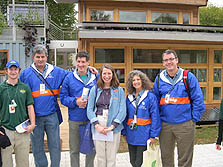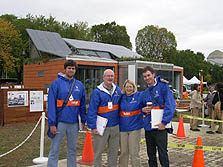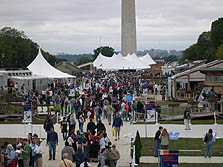

Members of the Architecture Jury were busy the past two day as the decided how teams fared in the architecture contest, which is worth the most points. Pictured, left to right, are Ed Mazria, Steve Badanes, Sarah Susanka, Susan Piedmont-Pallidino, and Ken Wilson, in front of NYIT.

The dwelling jury evaluated each house's consumer appeal. Pictures are Sam Grawe, Bob Burt, Katherine Salant, and Dennis Askins.

With the dry weather came longer lines. Visitors waited in long lines to tour the Madrid house.
Solar Decathlon 2005
Daily Journal — October 9, 2005
Awesome! Spectacular! Impressive! Well done! These are just a few of the comments from the Architecture and Dwelling juries as the toured the houses the past two days. All agreed that the level of sophistication and attention to detail were a step above the houses from the 2002 competition. After 14 hours of tours and two hours of deliberations, the jurors were still having difficulty ranking the teams. At one point the Architecture jury went back out into the village to look at some of the houses a second time as they deliberated if one house deserved a higher score than another. Finally, at 4 p.m. on Sunday they made their selections.
The Solar Decathlon has 10 contests, each of which are worth 100 points except Architecture, which is worth 200 points. Therefore, the highest possible point total is 1,100. The rules committee placed 200 points on Architecture based on the importance of integrating energy systems into aesthetic design and the acceptance of these technologies by the public. The Dwelling contest judges consumer appeal, another important factor necessary for public acceptance of solar technologies. Together they are worth 300 points, or 27% of the total points, which means teams that score high in these two contests will have the early advantage. Tomorrow at 10 a.m. Eastern time the results will be announced, and soon thereafter posted on the Web page, so please log on!
Yesterday was a sea of water and umbrellas. Today the rain stopped and the people came out in droves. We estimated well over 20,000 people visited the Solar Decathlon. There were long lines of people waiting to get into each house. Lines formed early and continued all day and into the evening. It was exhilarating to see so many people interested in the homes and eager to listen to the decathletes as they explained their design strategies.
As long lines began forming in early afternoon, the team strategies for this aspect of the competition came into play. Each had to move hundreds of people through their houses in the span of a few hours, and at the same time, convey a huge amount of information. More than half the teams had storyboards along the ramps leading into their houses that people could read as they waited in line. Cornell escorted people into their house in groups of 10, and kept them moving through various staging areas. A Michigan student talked to people in line and answered their questions from a balcony. But the New York Institute of Technology had the techie approach: They gave people in line a handheld device with a 10-minute animation describing the house design, its special features, and what inspired the team to come to the Solar Decathlon.
After eight hours of tours, I'm sure all the decathletes will be hoarse tonight!
Reporting from the village,
Richard King, Department of Energy
